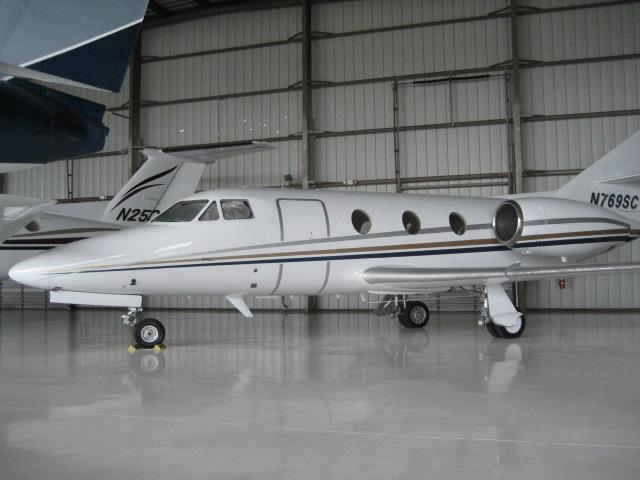


Aircraft Description
Background/History
The Falcon 10 design was undertaken by Dassault in the late 1960s in order to fill a gap between the company’s successful Falcon 20 and the smaller turboprop cabin-class business aircraft. The Falcon 10 was originally powered by General Electric CJ610 turbojet engines when it first flew in December 1970. However, Pan Am Business Jets Division, which placed the first order for the new type, required that turbofan engines be installed instead. The GE engines were subsequently replaced by a pair of Garret AiResearch TFE731-2 turbofans on the second prototype, and this configuration won FAA certification in 1973, with first deliveries beginning soon thereafter. The Falcon 10 was in production from 1973 through 1982 with some 189 aircraft having been built. In 1983, a series of design refinements resulted in the aircraft being redesignated the Falcon 100 and another 37 of this variant were built before production was finally halted in 1989.
Power
The Falcon 10 is powered by a pair of Honeywell TFE731-2-1C turbofan engines rated at 3,230lbs. of thrust each. Inspection interval on the engine core is 4,200 hours.
Avionics
A typical avionics package for the Falcon 10 might include dual Collins VHF20A comms, dual VIR30A navs, dual Collins FD109 flight directors, dual Collins DME 40, dual Collins ADF 60A, Collins ALT 50 radar altimeter, Collins AP105 autopilot, Universal UNS-1M FMS and GPS, and Sperry Primus 400 color weather radar.
Design Features
The Falcon 10 is a light, medium-range, twin turbofan-powered business jet configured as a cantilever, swept low-wing monoplane with a swept cruciform tail. The airframe is of aluminum monococque construction. The wing utilizes a supercritical airfoil optimized for cruise at high subsonic speeds and is equipped with wide-span double-slotted flaps and full leading edge slats to improve low speed handling characteristics. The retractable tricycle landing gear has dual wheels on each main mount and a single nose wheel. Refueling the aircraft can be accomplished from a single point near the right engine nacelle, or gravity fueling can be done over-wing into each tank if desired.
Accomodations
The interior of the Falcon 10 is normally configured to seat five to six passengers in an executive arrangement, with one or two forward- facing individual seats and two seats facing a rear bench seat. A lavatory seat is located on the starboard sidewall opposite the entry door. A 12cu.ft. baggage storage area is located aft behind the fold-down bench seat and is only accessable from inside the aircraft. The Falcon 10 is also adaptable to air ambulance and light utility configurations. Cabin dimensions are 12.9ft. in length, 4.8ft. in height and 5ft. in width.
| General | Falcon 10, DA-10 | |||
|---|---|---|---|---|
| Category | Jet < 20,000 lbs. | |||
| Years Aircraft Manufactured | 1973 – 1983 | |||
| Serial Number Range | 001 – 190 | |||
| Retail High Price | $1,295,000.00 / 1,016,186.50€ | |||
| Retail Low Price | $295,000.00 / 231,486.50€ | |||
| Characteristics | Falcon 10, DA-10 | |||
| Seating | 2+7 | |||
| Wing Loading | 72.2 | |||
| Power Loading | 2.9 | |||
| Noise(EPNdB): Takeoff/Sideline/Approach | 83.4/95.4 | |||
| External Dimensions (ft) | Falcon 10, DA-10 | |||
| External Length | 45.3 | |||
| External Height | 15.2 | |||
| External Span | 42.9 | |||
| Internal Dimensions (ft) | Falcon 10, DA-10 | |||
| Internal Length (Overall/Net Height) | 12.8 | |||
| Internal Height | 4.7 | |||
| Internal Width (Max/Floor) | 4.8 | |||
| Baggage | Falcon 10, DA-10 | |||
| External: Cu.Ft./Lb. | N/A | |||
| External: Cu.Ft./Lb. | N/A | |||
| Power | Falcon 10, DA-10 | |||
| Engines | 2 Hon TFE731-2-1C | |||
| Output (lbs ea.)/Flat Rating | 3,230 | |||
| Inspection Interval | 4,200c | |||
| Data based on latest manufactured year | ||||



